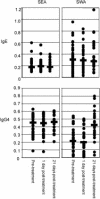Changes in IgE- and antigen-dependent histamine-release in peripheral blood of Schistosoma mansoni-infected Ugandan fishermen after treatment with praziquantel
- PMID: 15102330
- PMCID: PMC419341
- DOI: 10.1186/1471-2172-5-6
Changes in IgE- and antigen-dependent histamine-release in peripheral blood of Schistosoma mansoni-infected Ugandan fishermen after treatment with praziquantel
Abstract
Background: Parasite-specific IgE levels correlate with human resistance to reinfection with Schistosoma spp. after chemotherapy. Although the role of eosinophils in schistosomiasis has been the focus of a great deal of important research, the involvement of other Fcepsilon receptor-bearing cells, such as mast cells and basophils, has not been investigated in relation to human immunity to schistosomes. Chemotherapy with praziquantel (PZQ) kills schistosomes living in an in vivo blood environment rich in IgE, eosinophils and basophils. This releases parasite Ags that have the potential to cross-link cell-bound IgE. However, systemic hypersensitivity reactions are not induced by treatment. Here, we describe the effects of schistosomiasis, and its treatment, on human basophil function by following changes in total cellular histamine and in vitro histamine-release induced by schistosome Ags or anti-IgE, in blood samples from infected Ugandan fishermen, who are continuously exposed to S. mansoni infection, before and 1-day and 21-days after PZQ treatment.
Results: There was a significant increase in the total cellular histamine in blood samples at 1-day post-treatment, followed by a very significant further increase by 21-days post-treatment. In vitro histamine-release induced by S. mansoni egg (SEA) or worm (SWA) Ags or anti-IgE antibody, was significantly reduced 1-day post-treatment. The degree of this reduction correlated with pre-treatment infection intensity. Twenty-1-days post-treatment, SEA-induced histamine-release was still significantly lower than at pretreatment. Histamine-release was not correlated to plasma concentrations of total or parasite-specific IgE, nor to specific IgG4 plasma concentrations.
Conclusion: The biology of human blood basophils is modulated by S. mansoni infection and praziquantel treatment. Infection intensity-dependent suppression of basophil histamine-release, histamine-dependent resistance to infection, and similarities with allergen desensitisation are discussed as possible explanations of these observations.
Figures




Similar articles
-
Suppression of basophil histamine release and other IgE-dependent responses in childhood Schistosoma mansoni/hookworm coinfection.J Infect Dis. 2014 Oct 15;210(8):1198-206. doi: 10.1093/infdis/jiu234. Epub 2014 Apr 29. J Infect Dis. 2014. PMID: 24782451 Free PMC article.
-
SCHISTOSOMA MANSONI INFECTION AND THE ASSOCIATED ANTIBODY IMMUNE RESPONSE AMONGST RESIDENTS OF KIGUNGU ENTEBBE, UGANDA.East Afr Med J. 2012 Apr;89(4):111-20. East Afr Med J. 2012. PMID: 26856035
-
Effect of praziquantel treatment of Schistosoma mansoni during pregnancy on intensity of infection and antibody responses to schistosome antigens: results of a randomised, placebo-controlled trial.BMC Infect Dis. 2009 Mar 18;9:32. doi: 10.1186/1471-2334-9-32. BMC Infect Dis. 2009. PMID: 19296834 Free PMC article. Clinical Trial.
-
Population level changes in schistosome-specific antibody levels following chemotherapy.Parasite Immunol. 2019 Jan;41(1):e12604. doi: 10.1111/pim.12604. Parasite Immunol. 2019. PMID: 30467873 Free PMC article.
-
Reductions in genetic diversity of Schistosoma mansoni populations under chemotherapeutic pressure: the effect of sampling approach and parasite population definition.Acta Trop. 2013 Nov;128(2):196-205. doi: 10.1016/j.actatropica.2012.03.001. Epub 2012 Mar 15. Acta Trop. 2013. PMID: 22440199 Review.
Cited by
-
Eosinophils and helminth infection: protective or pathogenic?Semin Immunopathol. 2021 Jun;43(3):363-381. doi: 10.1007/s00281-021-00870-z. Epub 2021 Jun 24. Semin Immunopathol. 2021. PMID: 34165616 Review.
-
Associations of IL13 gene polymorphisms and immune factors with Schistosoma haematobium infection in schoolchildren in four schistosomiasis-endemic communities in Ghana.PLoS Negl Trop Dis. 2021 Jun 29;15(6):e0009455. doi: 10.1371/journal.pntd.0009455. eCollection 2021 Jun. PLoS Negl Trop Dis. 2021. PMID: 34185775 Free PMC article.
-
Schistosoma haematobium infection levels determine the effect of praziquantel treatment on anti-schistosome and anti-mite antibodies.Parasite Immunol. 2012 Jun;34(6):330-40. doi: 10.1111/j.1365-3024.2012.01363.x. Parasite Immunol. 2012. PMID: 22429049 Free PMC article.
-
Role in Allergic Diseases of Immunological Cross-Reactivity between Allergens and Homologues of Parasite Proteins.Crit Rev Immunol. 2016;36(1):1-11. doi: 10.1615/CritRevImmunol.2016016545. Crit Rev Immunol. 2016. PMID: 27480900 Free PMC article. Review.
-
Suppression of basophil histamine release and other IgE-dependent responses in childhood Schistosoma mansoni/hookworm coinfection.J Infect Dis. 2014 Oct 15;210(8):1198-206. doi: 10.1093/infdis/jiu234. Epub 2014 Apr 29. J Infect Dis. 2014. PMID: 24782451 Free PMC article.
References
-
- Medhat A, Shehata M, Bucci K, Mohamed S, Dief AD, Badary S, Galal H, Nafeh M, King CL. Increased interleukin-4 and interleukin-5 production in response to Schistosoma haematobium adult worm antigens correlates with lack of reinfection after treatment. J Infect Dis. 1998;178:512–519. - PubMed
-
- Hagan P, Blumenthal UJ, Chaudri M, Greenwood BM, Hayes RJ, Hodgson I, Kelly C, Knight M, Simpson AJ, Smithers SR, et al. Resistance to reinfection with Schistosoma haematobium in Gambian children: analysis of their immune responses. Trans R Soc Trop Med Hyg. 1987;81:938–946. doi: 10.1016/0035-9203(87)90359-2. - DOI - PubMed
-
- Rihet P, Demeure CE, Bourgois A, Prata A, Dessein AJ. Evidence for an association between human resistance to Schistosoma mansoni and high anti-larval IgE levels. Eur J Immunol. 1991;21:2679–2686. - PubMed
Publication types
MeSH terms
Substances
Grants and funding
LinkOut - more resources
Full Text Sources
Miscellaneous

